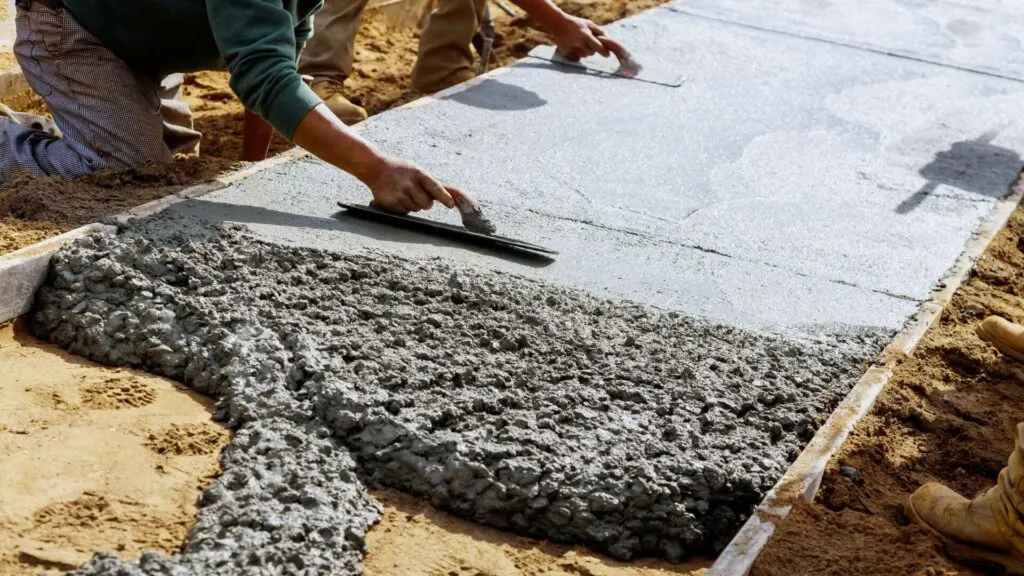Concrete is one of the most widely used construction materials in the world, known for its strength and durability. It is the backbone of modern construction and an integral part of commercial projects, residential buildings, and sidewalks.
However, the material’s durability is affected with time, requiring repair and replacement. Also, due to the increasing environmental concerns, the construction industry is focusing on finding more sustainable solutions. Asphalt and concrete are the most common materials used in sidewalk construction and repair. It is critical to take into account the environmental impacts of concrete in construction and manufacturing.
There is an increasing demand to find lasting and eco-friendly solutions for concrete sidewalk repair and replacement.

The Environmental Challenges of Concrete
Producing and usage of concrete lead to numerous environmental challenges, such as:
Carbon Emissions
A key ingredient in concrete is cement production. It accounts for about 8% of the global CO2 emissions. This is a major contributor to climate change.
Energy Consumption
Concrete production is a process that consumes a lot of energy and adds to the overall environmental impact of concrete.
Depletion of Resources
A huge amount of raw materials are required for manufacturing concrete. For instance, the extraction of clay and limestone leads to a decline in biodiversity and habitat loss.
Generate Waste
Concrete manufacturing produces waste materials like sludge and dust. These lead to air and water pollution.
Urban Heat Island Effect
The concrete surfaces in urban areas, such as sidewalks, absorb and preserve heat. This leads to increased temperatures and increases the effects of climate change.
Water pollution
The concrete construction sites add to water pollution. The runoff from these sites has harmful sediments and chemicals that can contaminate the water sources.
Environmental-friendly Concrete Solutions
Concrete construction and manufacturing have serious environmental impacts. By seeking creative technologies and adopting sustainable concrete solutions, the concrete industry can be successful in creating an environmentally safe future.
Concrete is a crucial component of our infrastructure and development. Concrete sidewalks are integral for pedestrian infrastructure. Concrete is widely used in sidewalk construction and repairs. The industry needs to look for sustainable solutions to work toward environment-friendly solutions:
Advanced Materials
Besides constructing buildings, concrete is used by sidewalk contractors in New York City for sidewalk repairs. One of the major aspects of sustainable concrete repair is using materials that reduce the environmental impact.
For example, using recycled materials like fly ash and recycled aggregates in the repair mix lessens the demand for raw materials. This leads to the diversion of waste from the landfills. It also helps in natural resource conservation and reduces the carbon footprint of concrete repair and other practices.
Technology for Effective Concrete Processes
Sustainable concrete sidewalk repair and other processes involve applying innovative techniques that help with the durability and longevity of the structures. There are advanced corrosion-resistant materials like fiber-reinforced polymers that can act as a substitute for traditional steel supports. These materials provide durability, reduced maintenance needs, and a longer life cycle.
As a result, it promotes sustainability by reducing the repair frequency and the impact on the environment.
Preventive Maintenance Strategies
Sustainable concrete sidewalk repair and reinforcement practices focus on applying preventive maintenance strategies so that sidewalks and other concrete structures don’t suffer structural damage. Regular inspection and timely repair of the defects reduce the risk of damage and repairs and extend their lifespan.
Carbon-Neutral Concrete
Making carbon-neutral concrete could be significant in reducing the high carbon emissions that accompany conventional concrete production. To make carbon-neutral concrete, alternative, low-emission cement and incorporating materials that absorb CO2 needs to be used in the concrete mix.
Recycling & Reusing
Recycling concrete waste is vital in reducing the demand for new materials. The environmental impacts that follow the extraction are automatically lessened. Turning old concrete into aggregate could help lessen waste and the need for new materials.
The government and the industry leaders should focus on investing in recycling facilities and encourage the use of recycled concrete.
Sustainable Construction Practices
The environmental impacts of concrete can be significantly reduced by following sustainable construction practices. Designing structures that last helps cut down on resources that are used for repair and reconstruction. Precast concrete is made off-site and brought to the site. It can save on materials and reduce waste.
Some other options for sustainable concrete construction include modular construction methods that include using components and integrating eco-friendly technologies like solar panels and green roofs.
Conclusion
Concrete is the preferred choice of construction material in buildings and sidewalks. However, it has numerous effects that are detrimental to the environment. Sustainability in concrete repair and reinforcement practices involves using the latest technology, recycled and advanced materials, and other maintenance strategies. By following these practices, the construction industry can reduce the environmental impacts of concrete, create durable structures, and foster a sustainable built environment

Jessi is the creative mind behind The Coffee Mom, a popular blog that combines parenting advice, travel tips, and a love for all things Disney. As a trusted Disney influencer and passionate storyteller, Jessi’s authentic insights and relatable content resonate with readers worldwide.
